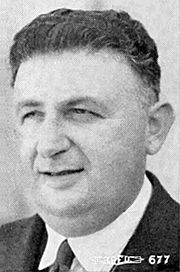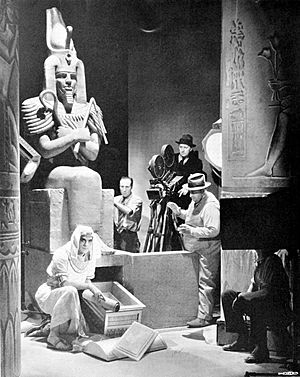Karl Freund facts for kids
Quick facts for kids
Karl Freund
|
|
|---|---|

Karl Freund in 1932
|
|
| Born |
Karl W. Freund
January 16, 1890 Dvůr Králové, Bohemia, Austria-Hungary
|
| Died | May 3, 1969 (aged 79) Santa Monica, California, U.S.
|
| Nationality | German |
| Occupation | Cinematography |
| Years active | 1926–1969 |
| Known for | Pioneer of Entfesselte Kamera |
| Children | Gerda Martel |
Karl W. Freund (born January 16, 1890 – died May 3, 1969) was a talented German-American cinematographer and film director. He is famous for his work on classic films like Metropolis (1927) and Dracula (1931). He also helped create the look of the popular TV show I Love Lucy (1951–1957). Freund was a true pioneer in how movies and TV shows were filmed, especially known for his "unchained camera" technique.
Contents
Early Life and Career Beginnings
Karl Freund was born in Dvůr Králové, a town in Bohemia. When he was 11, his family moved to Berlin, Germany. His career in film started early, in 1905, when he was just 15 years old. He began as an apprentice projectionist for Alfred Duskes films.
In 1907, he started working at the International Cinematograph and Light Effect Society. Freund was briefly in the Imperial Army during World War I. However, he was released from duty after only three months.
Early Film Work in Europe
Freund's film career really took off in 1905. By 1907, he was a newsreel cameraman. A year later, he worked for Sascha-Film in Vienna. In 1911, Freund moved to Belgrade to set up a film laboratory.
Freund worked as a cinematographer on over 100 films. These included important German Expressionist movies like The Golem (1920) and The Last Laugh (1924). He often worked with director Fritz Lang. Their most famous project together was Metropolis (1927).
Freund also helped write and film Berlin: Symphony of a Metropolis (1927). This film was directed by Walter Ruttmann. From 1926 to 1929, Freund was in charge of production at Fox Europa Film. Interestingly, Freund also acted in one film, Michael (1924). He played an art dealer in the movie.
Innovations in Filming Techniques
Early in his career, Karl Freund loved to experiment. He looked for new ways to film and new ideas for movies. In 1914, he worked with Oskar Messter, who was a pioneer in sound film technology.
The Unchained Camera Technique
Karl Freund was a leader in developing the "unchained camera" technique. This was a huge change in early filmmaking. Before this, cameras were usually stuck on a tripod. They could not move around the set.
With the unchained camera, the camera was finally free! It could move around the set, opening up thousands of new ways to film scenes. Freund was known for wearing the camera on his stomach and walking around while filming. He also put the camera on a cart that moved along a track. He even put cameras on cranes to get high-angle shots. These new methods made movies much more exciting to watch.
American Film and Television Career
Freund moved to the United States in 1929. There, he continued to work on many famous films. These included Dracula (1931) and Key Largo (1948).
For Dracula, the director, Tod Browning, often let Freund take charge of filming. This meant Freund was almost like an uncredited director for much of the movie. Freund won an Academy Award for Best Cinematography for his work on The Good Earth (1937).

Between 1921 and 1935, Freund directed 10 films. His most famous directed films are probably two horror films: The Mummy (1932), starring Boris Karloff, and Mad Love (1935), his last film as a director.
Freund worked for big studios like MGM and Warner Bros. In 1944, he started his own company, Photo Research Corporation. This company made TV cameras and tools to measure light.
Working on I Love Lucy
In the early 1950s, Desi Arnaz convinced Freund to be the cinematographer for the new TV show I Love Lucy. This show started in 1951. Critics praised Freund for the beautiful black and white look of the show.
More importantly, Freund created a special "flat lighting" system for filming sitcoms. This system is still used today! It lights up the whole set evenly, so there are no dark shadows. This allowed three cameras to film at once without needing to change the lighting for each shot.
Freund didn't invent the three-camera system. However, he made it perfect for filming with movie cameras in front of a live audience. The cameras used were special BNC Mitchell cameras on wheels. The middle camera took wide shots. The other two cameras were placed to the sides for close-ups.
Even with all his film experience, Freund found switching to TV challenging. Because I Love Lucy was filmed in front of a live audience, there were rules about where the cameras could be placed. Freund and his team also worked on other sitcoms, like Our Miss Brooks.
Photo Research Corporation and Inventions
In 1941, Karl Freund started Photo Research Corporation. He wanted to create products that would make motion picture photography better. One important invention was the Norwood Director light meter. This tool helped measure light directly.
After the first successful model, the company continued to improve it under the name Spectra. This light meter and another brightness meter earned Freund two Academy Awards for technical achievements. These awards recognized his important contributions to film technology.
The brightness meter became very popular. It was even used by astronauts in the 1950s on the Project ManHigh balloon missions. These missions reached almost 100,000 feet in the air!
Both Spectra and Photo Research still make excellent measurement equipment today.
Personal Life
In 1937, Karl Freund went back to Germany to bring his only daughter, Gerda Maria Freund (born 1916 – died 2017), to the United States. This saved her from the dangers of the concentration camps during World War II. Sadly, his ex-wife, Susette Freund, stayed in Germany. She died at the Ravensbrück concentration camp in 1942.
Selected Filmography
As cinematographer
- The Robber Bride (1916)
- The Queen's Love Letter (1916)
- The Giant's Fist (1917)
- Mountain Air (1917)
- The Princess of Neutralia (1917)
- The Man in the Mirror (1917)
- The Marriage of Luise Rohrbach (1917)
- Countess Kitchenmaid (1918)
- Put to the Test (1918)
- The Victors (1918)
- The Lady, the Devil and the Model (1918)
- The Ringwall Family (1918)
- Precious Stones (1918)
- Agnes Arnau and Her Three Suitors (1918)
- The Blue Lantern (1918)
- Die Arche (1919)
- The Night at Goldenhall (1920)
- Catherine the Great (1920)
- The Golem (1920)
- Der Januskopf (1920)
- The Oath of Peter Hergatz (1921)
- Children of Darkness (1921)
- The Rats (1921)
- The Story of Christine von Herre (1921)
- Lucrezia Borgia (1922)
- Louise de Lavallière (1922)
- The Last Laugh (1924)
- Michael (1924)
- Variety (1925)
- Tartuffe (1926)
- The Mill at Sanssouci (1926)
- Out of the Mist (1927)
- Doña Juana (1927)
- Metropolis (1927)
- Berlin: Symphony of a Metropolis (1927)
- A Knight in London (1929)
- Fräulein Else (1929)
- Sleeping Partners (1930)
- Bad Sister (1931)
- Dracula (1931)
- Back Street (1932)
- The Kiss Before the Mirror (1933)
- Camille (1936)
- The Good Earth (1937)
- Parnell (1937)
- Conquest (1937)
- Letter of Introduction (1938)
- Man-Proof (1938)
- Tail Spin (1939)
- Golden Boy (1939)
- Rose of Washington Square (1939)
- Balalaika (1939)
- Pride and Prejudice (1940)
- Green Hell (1940)
- Blossoms in the Dust (1941)
- Tortilla Flat (1942)
- Cry "Havoc" (1943)
- A Guy Named Joe (1943)
- Du Barry Was a Lady (1943)
- The Seventh Cross (1944)
- Without Love (1945)
- The Thin Man Goes Home (1945)
- A Letter for Evie (1946)
- Undercurrent (1946)
- Two Smart People (1946)
- That Hagen Girl (1947)
- This Time for Keeps (1947)
- Key Largo (1948)
- South of St. Louis (1949)
- Montana (1950)
- Bright Leaf (1950)
As director
- The Sensational Trial (1923)
- The Mummy (1932)
- Moonlight and Pretzels (1933)
- Madame Spy (1934)
- The Countess of Monte Cristo (1934)
- Uncertain Lady (1934)
- I Give My Love (1934)
- Gift of Gab (1934)
- Mad Love (1935)
As producer
- Madame Wants No Children (1926)
See also
 In Spanish: Karl Freund para niños
In Spanish: Karl Freund para niños
- List of German-speaking Academy Award winners and nominees

